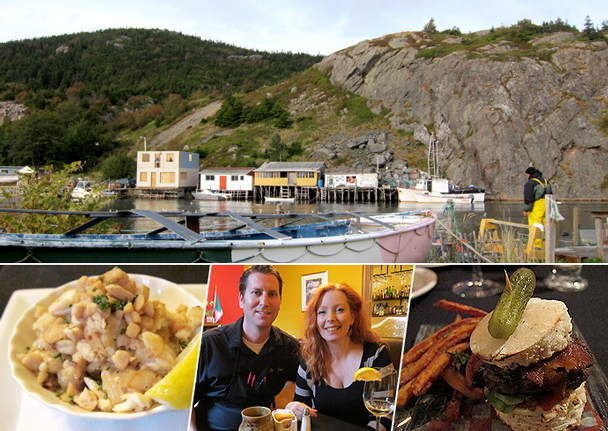Cod is king in Newfoundland, and goodness knows I had plenty on my trip there last fall: It was seared, salted, boiled, and fried and served every possible way, from meltingly tender cheeks to slightly rubbery tongue. I couldn't bring myself to kiss one, which happens to be a requirement—along with downing a shot of rum and reciting an old sailor's poem—of becoming an honorary Newfoundlander. Getting "screeched in" is practically a rite of passage for visitors to this large island (northeast of the more famous Prince Edward Island), and the fact that I avoided it means only one thing: I have to go back.
A rocky island roughly the size of Virginia but with only 1/16th the population, Newfoundland is located just a few hours south of Greenland, wedged between Quebec and Nova Scotia. Known for its jaw-dropping scenery—rugged cliffs, glacier-carved fjords, deserted beaches, and migrating icebergs—the sparsely populated island (along with its mainland counterpart, Labrador) makes up Canada's easternmost province. Thanks to its history as a colony of the United Kingdom until 1949, the island still has strong British and Irish influences, from its thriving pub culture to the unique brogue, more Gaelic than English, that characterizes a Newfoundlander's speech. A mere three hours by direct flight from the New York City area, Newfoundland is much closer than Europe, but still feels a world apart.
History and geography aside, it was the food that drew me to Newfoundland. I had been told there was a small culinary revolution afoot in St. John's, the province's historic capital, and I was curious to explore the uncharted territories of "nouvelle Newfoundland" cuisine.
After years of economic depression caused by the moratorium on cod fishing in 1992, Newfoundland's economy is finally picking up again thanks to oil and gas exploration in Labrador. "For the first time ever, there is a culinary scene in St. John's," said Nancy Brace, executive director of the Restaurant Association of Newfoundland and Labrador. Until very recently, "people made a half dozen dishes at home, and restaurants tended to be greasy spoons." Now, Brace said, young chefs who have worked and traveled abroad are coming home, "bringing with them a fresh perspective on Newfoundland ingredients."
This generation of prodigal young Newfoundland chefs includes Todd Perrin, a Top Chef Canada contestant and the owner of the Chef's Inn; Mark McCrowe of Aqua Kitchen & Bar; Brent Smith of the Newfoundland Chocolate Company; dynamic duo Shaun Hussey and Michelle LeBlanc of the hugely popular Chinched Bistro; and Jeremy Charles and Jeremy Bonia of Raymonds. For the record, my meal at Raymonds was one of the best I had all year.
While their menus may vary, this new crop of chefs and artisans have one thing in common—a passion for local Newfoundland ingredients. Many new restaurants have their own gardens for raising produce, despite Newfoundland's remarkably short growing season. Meats and fish are carefully sourced from surrounding farms and waters. The cod stocks, which were so tragically depleted by industrial fishing in the '70s and '80s, are slowly beginning to recover, and newer, sustainable methods like cod-pot fishing are helping the fish make a comeback in more ways than one.
During my visit I tried all sorts of local specialties: moose, which was delicious in a bourguignonne and in a burger; lamb raised on seawater-soaked grasses, which gave it an especially salty taste; cod tongues; nettle soup made with dried capelin fish; homemade charcuterie from local pigs and ducks; and an amazing variety of indigenous berries, such as marshberries, gooseberries, partridgeberries, and tart bakeapples. They were used in everything from chocolates to wines. But that's just the food.
Fruit wines, liqueurs, and brandies from local Rodrigues Winery were served as digestifs, or used to flavor desserts. I tried herbal birch sap wine that tastes like sake; fiery Newfoundland rum (a.k.a. screech); and a host of craft beers from local brewery Quidi Vidi, where two brew standouts were the Iceberg Beer, made from water harvested from, yes, icebergs, and their signature 1892 Traditional Ale, named for the year of the Great Fire that destroyed nearly all of St. John's.



 Pinterest
Pinterest


